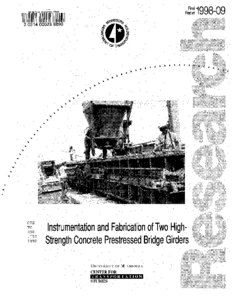Displaying results 1 - 28 of 28
The Effect of Transverse Stiffener Beams on Shear Transfer
Date Created
2003
Report Number
2003-12
Description
Effects of Vertical Pre-Release Cracks on Prestressed Bridge Girders
Date Created
2003
Report Number
2003-33
Description
Repair of Fatigued Steel Bridge Girders with Carbon Fiber Strips
Date Created
2003
Report Number
2004-02
Description
Evaluation of Electrochemical Chloride Extraction (ECE) and Fiber Reinforced Polymer (FRP) Wrap Technology
Date Created
2000
Report Number
2000-24
Description
Effects of Pre-Release Cracks in High-Strength Prestressed Girders
Date Created
2000
Report Number
2000-25
Description
Development Length of GFRP Reinforcement in Concrete Bridge Decks
Date Created
2000
Report Number
2000-26
Description
High-Strength Concrete Prestressed Bridge Girders: Long Term and Flexural Behavior
Date Created
2000
Report Number
2000-32
Description
Use of Adhesives to Retrofit Out-of-Plane Distortion Induced Fatigue Cracks
Date Created
2006
Report Number
2006-04
Description
Behavior of Concrete Integral Abutment Bridges
Date Created
2004
Report Number
2004-43
Description
Application of Precast Decks and Other Elements to Bridge Structures
Date Created
2006
Report Number
2006-37
Description
Retrofitting Shear Cracks in Reinforced Concrete Pier Caps Using Carbon Fiber Reinforced Polymers
Date Created
2005
Report Number
2005-13
Description
Anchorage of Shear Reinforcement in Prestressed Concrete Bridge Girders
Date Created
2014
Report Number
2014-36
Description
Modeling and Monitoring the Long-Term Behavior of Post-Tensioned Concrete Bridges
Date Created
2014
Report Number
2014-39
Description
Instrumentation, Monitoring, and Modeling of the I-35W Bridge
Date Created
2012
Report Number
2012-24
Description
Full-Depth Precast Concrete Bridge Deck System: Phase II
Date Created
2012
Report Number
2012-30
Description
Feasibility of Vibration-Based Long-Term Bridge Monitoring Using the I-35W St. Anthony Falls Bridge
Date Created
2017
Report Number
2017-01
Description
Investigation of Shear Distribution Factors in Prestressed Concrete Girder Bridges
Date Created
2016
Report Number
2016-32
Description
Discrepancies in Shear Strength of Prestressed Beams with Different Specifications
Date Created
2010
Report Number
2010-03
Description
Instrumentation and Fabrication of Two High-Strength Concrete Prestressed Bridge Girders
Date Created
1998-01
Report Number
1998-09
Description
Shear Capacity of High-Strength Concrete Pre-stressed Girders
Date Created
1998-05
Report Number
1998-12
Description
Monitoring and Analysis of Mn/DOT Precast Composite Slab Span System (PCSSS)
Date Created
2008
Report Number
2008-41
Description
Self-Compacting Concrete (SCC) for Prestressed Bridge Girders
Date Created
2008
Report Number
2008-51
Description
Shear Capacity of Prestressed Concrete Beams
Date Created
2008
Report Number
2007-47
Description
Ten-Year Review of Monitoring System on I-35W Saint Anthony Falls Bridge
Date Created
2020
Report Number
2020-19
Description
Displacement Monitoring of I-35W Saint Anthony Falls Bridge with Current Vibration-Based System
Date Created
2019
Report Number
2019-05
Description




























